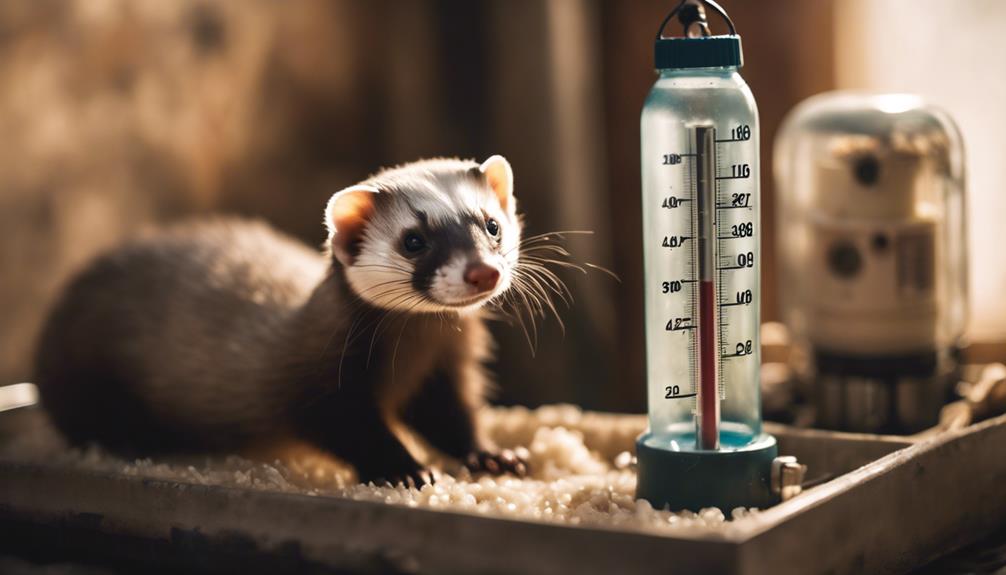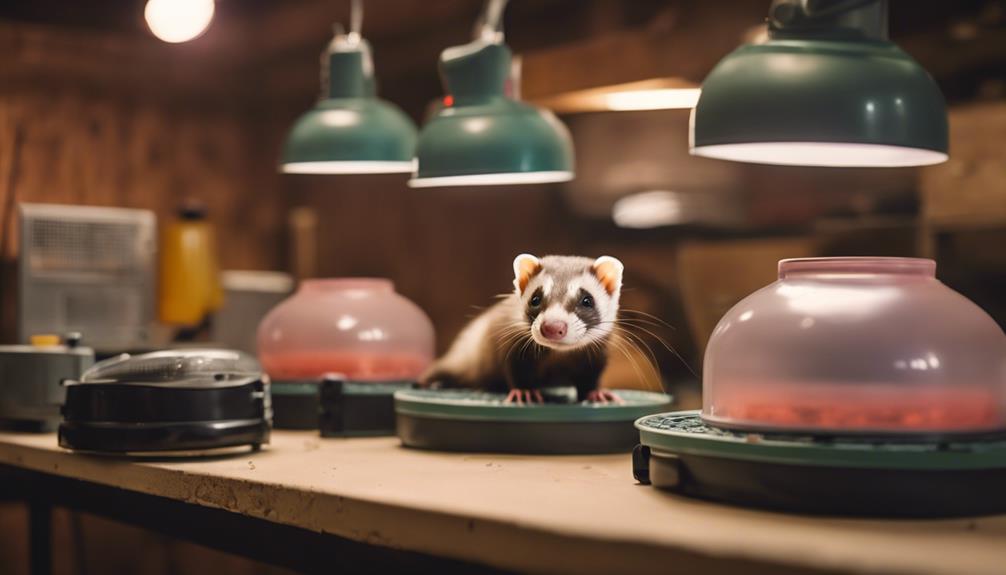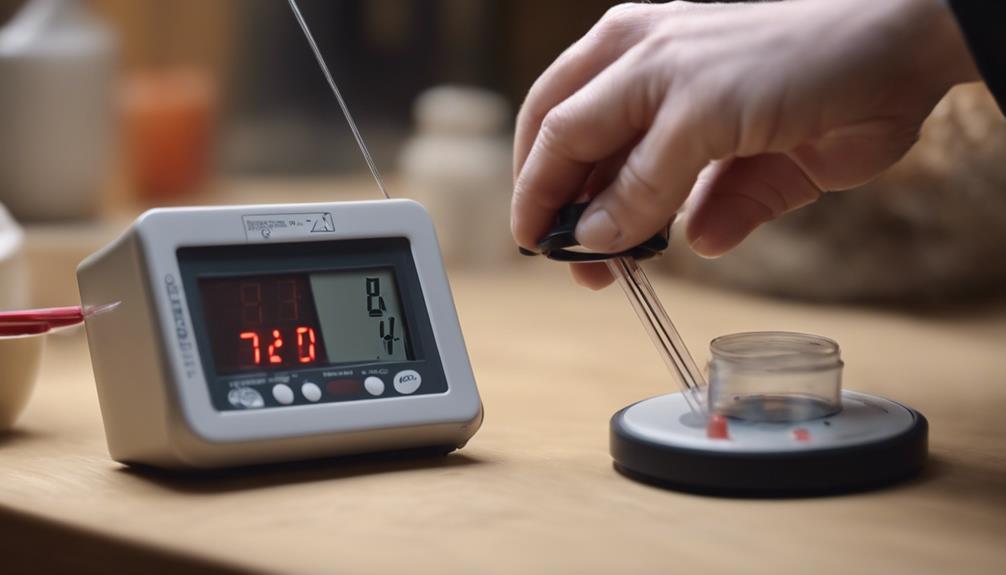How to Maintain the Ideal Temperature in Ferret Habitats

Maintaining the ideal temperature for your ferret's habitat is crucial for their health and well-being. Here are some tips to help you ensure your ferret's environment stays comfortable:
- Keep the temperature between 60-80 degrees Fahrenheit.
- Use a thermometer to monitor the temperature regularly.
- Provide proper ventilation to prevent overheating.
- Avoid placing the cage in direct sunlight or near heat sources.
- Consider using a fan or air conditioning during hot weather.
- Use heating pads or blankets during colder months, but make sure they cannot chew on them.
- Monitor your ferret for signs of overheating or being too cold, such as lethargy or shivering.
Remember, maintaining a consistent and comfortable temperature in your ferret's habitat is essential for their overall health and happiness.
Importance of Proper Temperature Control
Maintaining the correct temperature within a ferret habitat is crucial for the health and well-being of these curious creatures. Ferrets are sensitive to temperature changes, requiring a thermal gradient in their environment to mimic their natural habitat. Proper climate control is essential to prevent heat stress or hypothermia in ferrets.
Creating a thermal gradient involves setting up different temperature zones within the habitat. The ideal temperature range for ferrets is between 60-80 degrees Fahrenheit. This range allows them to regulate their body temperature effectively by moving to areas that suit their needs, ensuring their comfort and health.
Climate control systems such as thermostats and heat lamps can help maintain a stable temperature in the ferret habitat. It's vital to monitor and adjust these systems regularly to ensure that the temperature remains within the optimal range. Failure to provide proper temperature control can lead to health issues and discomfort for ferrets, highlighting the importance of maintaining a suitable environment for these pets.
Understanding Ferret Temperature Preferences

Understanding the temperature preferences of ferrets is essential for creating a suitable habitat that promotes their well-being and comfort. Ferret behavior and thermal comfort play significant roles in determining the ideal temperature range for these playful creatures.
Here are three key points to consider when understanding ferret temperature preferences:
- Behavior Cues: Observing your ferret's behavior can provide valuable insights into their thermal comfort. If they're seeking out warm spots or huddling together, they might be feeling cold and require a warmer environment. On the other hand, if they're panting or seeking cool surfaces, they may be too hot and need a cooler space.
- Thermal Comfort Zones: Ferrets generally prefer temperatures between 60-80°F (15-27°C). Maintaining their habitat within this range helps ensure they're comfortable and thriving.
- Adaptation to Temperatures: Ferrets can adapt to a certain extent to different temperatures, but sudden extreme changes can stress them. Gradual adjustments in temperature are recommended to allow them to acclimate comfortably.
Choosing the Right Heating Equipment

When selecting the appropriate heating equipment for a ferret habitat, it's crucial to consider their natural temperature preferences and the efficiency of the heating devices available. Ferrets prefer temperatures between 60-80°F (15-27°C), making it essential to choose heating equipment that can maintain these conditions.
When it comes to heating safety, opt for devices with automatic shut-off features to prevent overheating and potential hazards. Energy efficiency is also key to ensure that the heating equipment doesn't consume excessive power, leading to high electricity bills.
Look for heating devices that are specifically designed for small animal habitats, as they're tailored to provide safe and efficient heating for ferrets. Additionally, consider using ceramic heat emitters or heating pads that emit gentle warmth without emitting light, as ferrets are sensitive to bright lights during their resting periods.
Monitoring Temperature Levels Regularly

Regular monitoring of temperature levels in a ferret habitat is essential to ensure the environment remains within the optimal range for their well-being. To effectively manage this task, consider the following:
- Temperature Monitoring Techniques: Utilize digital thermometers placed at different levels of the habitat to ensure accurate readings. Additionally, consider investing in temperature-controlled devices for automated adjustments.
- Seasonal Adjustments: Be mindful of temperature fluctuations during different seasons and adjust heating equipment accordingly. Monitor indoor and outdoor temperatures to ensure a comfortable environment for the ferrets year-round.
- Heating Pad Safety, Energy Efficiency: When using heating pads, ensure they've safety features such as automatic shut-off to prevent overheating. Opt for energy-efficient heating equipment to maintain a cozy habitat while minimizing energy consumption.
Regularly checking and adjusting temperature levels based on these techniques and considerations will help create a comfortable and safe habitat for your ferrets, promoting their well-being and happiness.
Implementing Cooling Strategies in Summer

When combating the summer heat in a ferret habitat, strategic fan placement can significantly aid in cooling the environment.
Additionally, utilizing ice packs strategically placed near the ferret's resting areas can provide relief from high temperatures.
Fan Placement Tips
Proper placement of fans within the ferret habitat is crucial for effectively implementing cooling strategies during the summer months. Ensuring optimal air circulation is key to maintaining a comfortable environment for your ferrets.
Here are three fan placement tips to help you achieve this:
- Position Fans Strategically: Place fans at opposite ends of the habitat to promote cross-ventilation and create a consistent breeze throughout the space.
- Avoid Directly Blowing Air on Ferrets: Direct airflow towards the walls or ceiling to prevent drafts that may cause discomfort to your ferrets.
- Utilize Oscillating Fans: Oscillating fans can help distribute air more evenly, preventing stagnant air pockets and ensuring a well-ventilated habitat for your furry friends.
Ice Pack Usage
To effectively cool a ferret habitat during the summer months, consider incorporating ice packs strategically to help regulate the temperature and create a comfortable environment for your furry companions. Ice packs offer several benefits when placed correctly in the habitat. They can provide direct cooling relief, especially when ferrets seek out cooler spots in their habitat. Additionally, ice packs can be placed near the ferret's sleeping area to keep them comfortable during the hottest parts of the day. Another cooling option to consider is using cooling mats, which can also be effective in helping lower the temperature in the habitat. By incorporating these cooling strategies, ferret owners can ensure their pets stay cool and healthy during the warmer months.
| Ice Pack Benefits | Cooling Mat Options |
|---|---|
| Direct cooling relief | Cooling mats with gel technology |
| Can be placed near sleeping area | Elevated cooling pads |
| Helps regulate temperature | Portable and easy to use |
| Provides comfort during hot days | Durable and long-lasting |
| Aids in maintaining a cool environment | Effective in lowering habitat temperature |
Adjusting Temperature for Ferret Health Issues

Maintaining the ferret habitat temperature is crucial in addressing specific health issues that may arise. Ensuring the ideal temperature range can significantly impact ferret health and well-being.
Here are three key considerations to adjust the temperature for ferret health issues:
- Regulating Respiratory Health: Ferrets are prone to respiratory infections, and maintaining a warm and dry environment can help prevent such issues. Ensure the habitat isn't too cold or drafty, as this can exacerbate respiratory problems.
- Managing Digestive Health: Temperature fluctuations can impact ferret digestion. Avoid exposing ferrets to extreme cold or heat, as it can lead to gastrointestinal disturbances. Maintaining a consistent temperature can support their nutritional needs and overall digestive health.
- Preventing Stress-Related Illnesses: Ferrets are sensitive animals, and sudden temperature changes can stress them, making them more susceptible to illnesses. By keeping the habitat temperature stable and comfortable, you can reduce the risk of stress-related health issues.
Creating a Comfortable Sleeping Environment

Ferrets need a cozy and safe environment to sleep in, making bedding choices crucial.
Temperature-regulating hideouts can help ensure that they stay comfortable throughout the night.
Accessorizing their sleeping area with cozy items can further enhance their sleep quality.
Bedding Choices for Comfort
Selecting the appropriate bedding is crucial for ensuring your ferret has a comfortable and cozy sleeping environment. When choosing bedding for your ferret's habitat, consider the following:
- Soft Materials: Opt for soft bedding materials like fleece or plush fabrics to provide a cozy and gentle resting place for your ferret.
- Absorbency: Choose bedding that's absorbent to help keep your ferret dry and comfortable, preventing moisture buildup that could lead to health issues.
- Easy to Clean: Select bedding that's easy to clean and maintain, promoting a hygienic environment for your ferret to rest in.
Temperature-Regulating Hideouts
When creating a comfortable sleeping environment for ferrets, consider incorporating temperature-regulating hideouts to provide a cozy retreat for your pet. Ferrets are known for their temperature-sensitive behavior, making it crucial to offer them a snug and warm place to rest. Heating alternatives such as heated pads or thermal blankets can be placed inside these hideouts to maintain an ideal temperature for your furry friend. Here is a table illustrating some popular options for temperature-regulating hideouts:
| Type of Hideout | Material | Features |
|---|---|---|
| Thermal Cave | Fleece | Retains heat effectively |
| Heated Hammock | Plush fabric | Adjustable warmth settings |
| Cozy Tunnel | Sherpa lining | Provides insulation |
Cozy Sleep Accessories
To enhance your ferret's sleeping environment, consider incorporating cozy sleep accessories that promote comfort and relaxation. Here are three essential items to create a cozy sleep space for your furry friend:
- Sleep Hammocks: Ferrets love to snuggle up in hammocks, providing them with a cozy elevated spot to rest and sleep. These hammocks offer a secure and comfortable place for your ferret to relax.
- Fleece Blankets: Soft fleece blankets are perfect for lining your ferret's sleeping area. They provide warmth and a plush surface for your ferret to curl up on, promoting a restful sleep.
- Cushioned Beds: Adding a cushioned bed to your ferret's habitat gives them a soft and cushioned surface to sleep on, ensuring they've a cozy and supportive spot for napping.
Frequently Asked Questions
Can Ferrets Handle Extreme Temperature Fluctuations, or Is It Important to Maintain a Consistent Temperature in Their Habitat?
Ferrets have limited temperature tolerance and rely on consistent habitat conditions. Their climate adaptation is geared towards moderate temperatures. Sudden fluctuations can stress them. Maintaining a stable environment helps ensure their well-being and health.
Are There Any Specific Temperature Ranges That Should Be Avoided to Prevent Health Issues in Ferrets?
Is there a temperature range that could harm ferrets? Temperature regulation is crucial for their health. Extremes can jeopardize their well-being. Maintaining an ideal temperature is vital to prevent health issues and ensure a comfortable habitat for ferrets.
How Can I Determine if My Heating Equipment Is Providing Enough Warmth for My Ferrets?
To determine if heating equipment provides enough warmth for ferrets, observe their behavior near the heat source. Ensure proper heating efficiency by choosing suitable insulation options and monitoring temperatures. Create thermal gradients in the habitat for comfort.
Are There Any Natural Cooling Methods That Can Be Used in Addition to Traditional Cooling Strategies?
In the realm of ferret care, exploring nature's cool embrace offers an oasis amidst traditional cooling tactics. Utilize shady spots, breezy airflow, and cooling pads to complement standard methods, ensuring ferrets thrive in comfort.
What Are Some Signs That My Ferrets May Be Too Hot or Too Cold, and How Should I Adjust the Temperature Accordingly?
Signs of a ferret being too hot include excessive panting and lethargy, while shivering and seeking warm spots indicate they might be too cold. Adjust temperatures by using heat lamps or cooling pads, placing thermometers strategically, and insulating their habitat.











